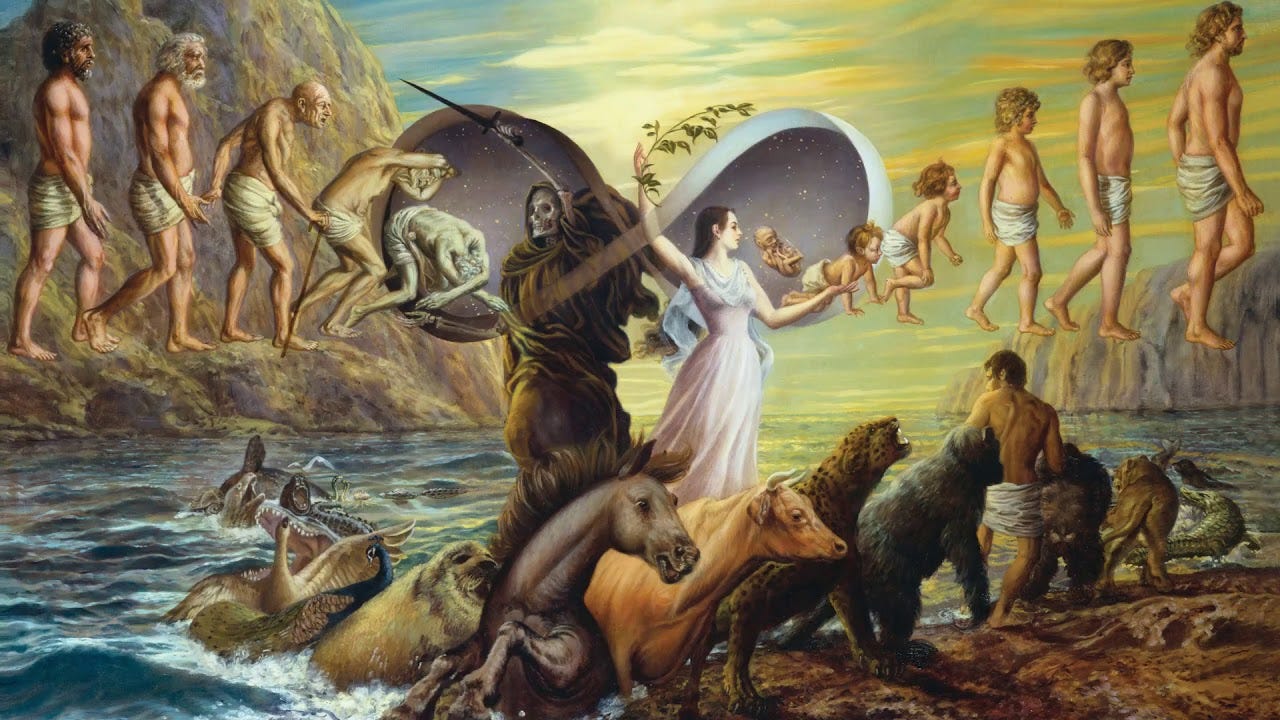Evidence of Reincarnation
The irrefutable proof that consciousness goes on. (Part 4 of Mysteries of the Mind)
wrote a marvellous essay on Transhumanism and the topic of consciousness living on.
This is such an incredibly deep, complex and fascinating subject that we can’t seem to have sufficient material to satisfy our curiosity—and neither does science.
There's an influx of additional evidence that past lives are, in fact, something that we can remember up to a certain age, usually between 2 and 3 years of age. The brain erases those memories as we develop more brain matter, and those recollections slowly disappear.
The brain is a fantastic computer; as such, it does what it must to protect itself from harm. In its infinite wisdom, we assume that the brain includes forgetting as part of its discretion. If we continue to remember our past lives, conditions could easily lead us to madness.
Typical Features
Investigators found that the subjects in these cases tended to talk about a past life at a very young age. They often started at age 2 or 3 and stopped by age 6 or 7. They made their statements about past lives spontaneously. They did so without using hypnotic regression. The children described their recent lives. The time between the death of the previous person and their birth was only 15 months. They lived ordinary lives, usually in the same country. Some said they were dead family members. But others, like Kumkum, talked of being strangers in other places. In those cases, if the children gave enough details, such as the name of the other location, people could go there and find that someone had died. Their life matched the details given by the child. The only part of their previous life that was often unusual was the mode of death. Over 70% of the previous personalities had died by unnatural means. They often died violently or suddenly. Besides the statements, many of the children showed behaviours that seemed connected to their previous lives. Many longed for the previous family. They also had emotions for individual family members. These emotions matched the relationship the previous personality had with them. In the cases involving violent death, over 35% of the children showed phobias related to the mode of that death (Stevenson, 1990). In addition, many of the children practised repetitive play. It seemed linked to the previous life. They most often acted out the old job and occasionally re-enacted the death scene (Stevenson, 2000).
We can only explain some extraordinarily documented instances by accepting that we have lived before. They are so exceptional that the only plausible explanation exists. We have lived before. Here are some examples:
Children's reports
Children often start reporting past lives at 35 months old. Some children may make emotionless statements. But many are intensely emotional about their claims. For example, some children may cry or beg to go back to their previous family. Others may show intense anger. They do this, especially to killers. This happens when the previous personality has been murdered. The stronger the evidence for a connection to the previous life, the more emotion the child may show when talking about that life. Dr. Ian Stevenson, a psychiatrist at the University of Virginia School of Medicine, pioneered research in this area. He spent much of his career collecting and examining such cases. Typically, this happens between ages 2 and 4 (with a mean age of 35 months). At that time, such children start talking about their previous life. They often speak about the events that led up to their deaths. They sometimes use the present tense, as if their previous life were still continuing. In some cases, Stevenson could identify the person the child claimed to be. He verified the information by speaking to the deceased's relatives.
Since Stevenson’s death, other researchers have followed his lead. Researchers have studied around 2500 reports of children's past-life memories. Research has shown that the children’s previous lives ended early and unnaturally. They often involved violence, suicide, or an accident. In almost three-quarters of cases, the “previous personality” (in the term coined by Stevenson) died relatively young. A quarter died before the age of 15. On average, the children linked to the previous personalities were born four and a half years after the deaths.
Modern researchers check the accuracy of children’s accounts. They look for any chance that the kids gained information through mundane ways or were fantasizing. Or that their parents may be embellishing their stories. Often, researchers give the children recognition tests. For example, they show them a set of photos and ask them to pick one related to their past personality. They might show pictures of houses and ask the person to pick the one in which their previous personality lived. In this scenario, participants might see pictures of women and have to choose which one was their previous personality's wife.
The most well-known researcher in this field is Jim Tucker. He is a professor of psychiatry and neurobehavioral science at the University of Virginia. I’ll describe one of the cases Tucker has investigated. Over the years, Stevenson has been studying these cases. The subjects were born with birthmarks or defects. They seemed to match wounds suffered by the previous personality. He did not report any of the cases until he could publish them as a collection. This was an extensive collection. In 1997, Stevenson published "Reincarnation and Biology: A Contribution to the Cause of Birthmarks and Birth Defects". It was two volumes and 2,200 pages. It had over 547 cases of "Children Who Claim to Remember Previous Lives" (Stevenson, 1997). He also wrote a shorter synopsis of that work. Stevenson (1997) called it 'Where Reincarnation and Biology Intersect'. In these books, Stevenson presented the cases. He described his efforts to verify that the birthmarks or defects did match wounds on the bodies of the previous people. Efforts included obtaining autopsy reports, if available. Also, medical records or police reports. If no written records were available, eyewitnesses could testify about the wounds. He also included many pictures. They showed birthmarks that were not the plain blemishes seen on babies. The subjects included a girl born with very deformed fingers. She remembered a man who had chopped off his fingers. There was also a boy with only stubs for fingers on his right hand. He remembered the life of a boy in another village who lost the fingers of his right hand in a fodder-chopping machine. Another boy had a small, round birthmark on the back of his head and a larger, irregular birthmark on the front. He remembered a teacher whom someone had shot from behind and killed. Finally, a girl remembered the life of a man who had skull surgery. He had what Stevenson called the most extraordinary birthmark he had ever seen. It was a 3-cm-wide area of pale, scar-like tissue that extended around her entire head. These cases showed that this thing was not just kids' memories. It also did not depend only on informants' memories. The birthmarks and birth defects were evidence of carryover from a deceased person. They showed that this carryover could affect a fetus.
Vladimir Levinski was born David Secombe in England in the 1930s. He had an innate gift for playing the piano. He taught himself to be a concert pianist by age 5. When asked about lessons, he said, “I have no time for them, I have a technique of my own.” Levinski was so gifted and so young. He came to see himself as the reincarnation of Franz Lizst, the German composer and pianist. By age 21, he was performing for packed concert halls, known as the “Paganini of the Piano.” Unfortunately, Levinski’s interest in Lizst became an obsession. This happened when he was playing a concert on January 23, 1952. He stopped playing halfway to talk about Lizst. The audience felt disappointed. But, Levinski felt the concert was a “big success.” He felt this because he experienced it as only the reincarnation of the renowned composer and performer Lizst, could.
Kumkum Verma, a girl in India, is an example of the subjects that Stevenson studied (Stevenson, 1975). She was from a village, but when she was 3 years old, she began saying that she had lived in Darbhanga, a city of 200,000 people that was 25 miles away. She named the district of the city where she said she had lived; one of artisans and craftsmen, and her family did not know anyone from that district. Kumkum made many statements, and her aunt wrote down many of them. Stevenson lost some of her notes, but she was able to get a copy of 18 of Kumkum's statements that her aunt had recorded. The details included her son's name and the life she was describing.





